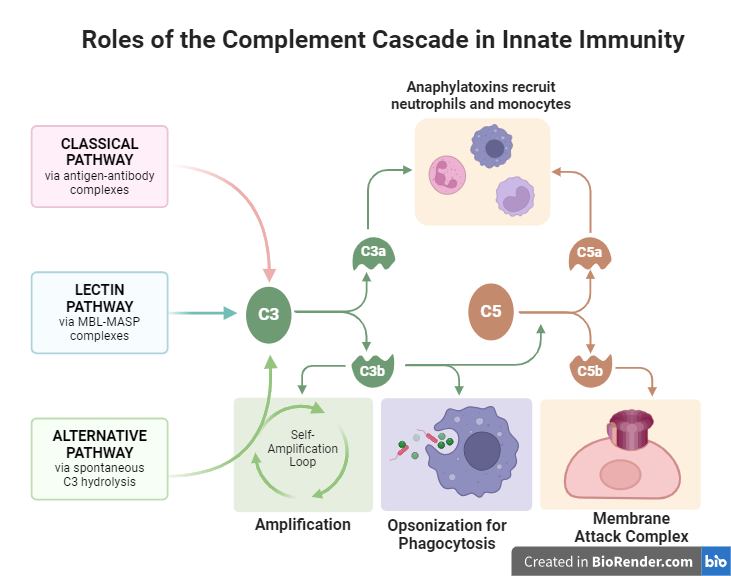Introduction:
The complement system is a part of immune system to protect the body from foreign particles that can damage the body.
Initially, complement was defined as “the activity of blood serum that completes the action of antibody induce a series of inflammatory responses that help to fight infection”.
At present, the complement system consists of over thirty soluble and cell-bound proteins and glycoproteins that interacts in a highly regulated cascade, following the initial activation, and carry out a number of basic functions.
The components of complementary system are synthesized mainly by liver hepatocytes. These components are designated by the numerals such as C1 to C9 by the letter symbols.
Functions:
- Activation of several protein that bind to the pathogen, lysis of cells, bacteria, and viruses
- Opsonization which promotes phagocytosis of particular antigens and promotes tissue regeneration, differentiation.
- Activation of immune response, such as inflammation, and secretion of immunoregulatory molecules that amplify or alter specific immune response.
- Removal of immune complexes i.e., Ag-Ab complexes from the circulation to the spleen and liver, where they are phagocytosed by macrophages. Thus, the complement system is important in both innate and acquired immunities.
Types:
The complement system needs to be activated before it takes effect; the activation can occur in of the following three ways:
The classical pathway
The classical pathway is directly triggered by pathogen or indirectly by antibody binding to the pathogen surface begins with the soluble antigen-antibody complex involves the formation or binding of antibody to an antigen present on a cell, e.g., bacterial cell.
C1, which has a total of 22 subunits, can also attach directly to the surfaces of some pathogens, as well as the C-reactive protein (CRP) produced during the acute phase of innate immunity.
IgM and certain subclasses of IgG activate the classical pathway; antigen-bound antibody makes a binding site available in its Fc region for binding of the complement C1.
| Feature | Classical | Alternative Pathway | Lectin |
| Initiated by | Ag-ab complex | Cell surface constituents foreign to host, e.g., bacteria | Binding of MBL to mannose residues on microbial cell surface |
| Initiation reaction Cleavage of C3 | C1 binds Fc regions of Ab in Ag-Ab complex By C3 invertase | C3b binds foreign cell surface Initially, spontaneous; later by C3bBb that has C3 convertase activity | Most likely by C3 invertase |
| Progress through | C1 to C4 to C2 to C3 to C5 | C3 to factor B to Factor D to Properdin to C5 | MBL to MASP to C4 to C2 to C3 to C5 |
| Products | Anaphylatoxin (C4a, C3a) Opsonin (C3b, major opsonin) Membrane- attack complex (C5b6789) causing cell lysis | Anaphylatoxin (C3a) Opsonin (C3b major opsonin) Membrane attack Complex (C5b6789) Cell lysis; cell lysis | Anaphylatoxin (C3a, c4a) Opsonin (C3b major opsonin) Membrane attack Complex (C5b6789); Cell lysis |
Table: The characteristic features of classical, alternative and lectin pathways of the complement system
The Alternative pathway
This pathway is a component of the innate immunity, and is the major pathway of complement activation. The alternative pathway id initiated by various cell surfaces constituents that are foreign to the host, e.g., certain wall constituents of both gram negative and gram-positive bacteria.

Fig: Types of complement system and the role of complement cascade in a innate immunity
The Lectin pathway
Lectins are the protein that bind to a carbohydrate residue of a glycoprotein or a polysaccharide. This pathway is initiated when MBL (Mannose-binding lectin), which is produced in inflammatory response, binds to a mannose residue on a glycoprotein or a carbohydrate. Now, MASP (MBL associated serine protease) binds to the MBL to form an enzymatically active complex that cleaves C4. Ultimately, a C5 convertase is produced that leads to the formation of MAC.
